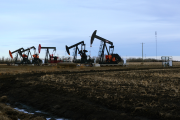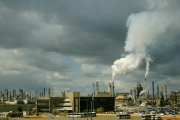The financial challenges oilsands producers are facing have a way of putting things into perspective. This time last year the sector was booming. Prospective customers and investors were courted with swagger. Then in September the price of oil plummeted and unemployment rose in Alberta. Last week, the Canadian Association of Petroleum Producers (CAPP) revised its production forecasts downward signaling slower-than-anticipated growth. A provincial recession is in the cards.
But there’s an upside to the downturn. As production slows and companies ease expansion plans, it’s time to take a sober look at how the oilsands sector can position itself to compete in a changing, carbon constrained global market.
A more resilient future
The oilsands — a high-cost, high-carbon source of energy — pose investor risk in a world moving toward cleaner, more efficient and lower-carbon sources. Over the short-term, sluggish growth in China, Iran’s re-entry into the oil market and recovery in Iraqi oil production suggests lower prices may be here for a while. Over the long-term the global shift to smart urban planning, bottom-up mobility solutions like Car2Go, a tripling of vehicle efficiency, the cost of an electric vehicle battery continuing to shrink and growing investor fears of “stranded assets” prompting fossil fuel divestment could combine to keep global demand for oil constrained. Instead of oil growing from 90 million barrels per day to 120-130 million between 2015-2030, what if these trends caused consumption to flatline? Were this the case, oil prices could stay low for the foreseeable future — bad news for high-cost projects planned in the oilsands.
Meanwhile, the case for action to avoid dangerous climate change grows stronger. No executive I know takes pleasure in 3-4°C of global warming being a byproduct of his or her shareholder allocation. Many oil and gas companies now call for a 2°C warming policy, internally price carbon and aim to produce the lowest carbon barrel of oil possible. This is admirable. But even if oil and gas companies could take 100 per cent of carbon pollution out of the production process – and that’s hard to imagine anytime soon – the overall greenhouse gas savings would not be enough given that most of emissions happen at the point of combustion. We simply need to burn a lot less oil.
Many in Calgary now quietly admit the type of production growth envisioned recently — upwards of six, seven or eight million barrels per day — is now a remote possibility. It means we now have an opportunity, and necessity, for a new business plan based on responsible development that respects the inherent limits of natural systems, the wellbeing of Alberta’s workers, the health of First Nations communities and delivers stable jobs and prosperity. A credible, science-based business plan would be built around these metrics and would set our oil and gas companies up to enjoy higher levels of public trust and long-term resiliency as they gradually transition away from fossil fuels.
Achieving this vision, however, requires a paradigm-shift for an industry that was based on a high growth model, but needs to transition to — dare I say it — the mindset of a rapidly maturing industry.
Maturing the paradigm
A truly science-based approach to oilsands development requires changes to current practices — both by industry and the government bodies that oversee it. It requires enforcing the good rules and regulations that exist and making new laws where existing ones fall short — as they do on carbon pollution.
Reducing emissions is the critical component of any blueprint for making the industry more resilient. This requires gearing production toward a level that is aligned with Canada’s international climate commitments and credible third-party assessments of how much fossil fuel production can be sustained while maintaining a stable climate. According to the International Energy Agency’s 2010 report — which looked at demand for oilsands under various scenarios — the sector would still be supplying energy in a world that is serious about cutting carbon pollution, but at lower production volumes.
A meaningful price on carbon pollution can improve consumption patterns and upstream efficiency. It can generate revenue used to balance government budgets or reduce corporate and personal taxes. Money should also be invested in clean energy initiatives to further diversify the economy.
Energy producers are already preparing for the time when managing carbon pollution will be incorporated in the cost of doing business. Earlier this month, the heads of Europe’s top oil companies published a letter in support of carbon pricing; the CEO of Suncor made a similar appeal last week, citing a well-designed carbon price as a key to creating certainty and helping the oilsands industry compete in the longer term.
In tough times, such proposals can be dismissed as impractical. But imagine if we applied that thinking to any other industry: would we tolerate fewer safety checks for airlines when ticket sales are down?
It’s nonsensical to argue rules should only apply during good times. And it’s certainly not in the sector’s self-interest.
An unsustainable strategy
In the past decade, the environmental impacts of oilsands production have repeatedly made headlines around the world. Those impacts have been a direct result of lax enforcement and poor choices by oilsands producers. This international scrutiny has ultimately been good for the industry, creating an incentive to improve environmental standards and practices. And just last week, the leaders of the world’s top economies pledged to phase-out fossil fuels entirely by the end of the century.
If, as Robert Frost once wrote, there’s no way out but through, then oilsands producers will need to re-think their business strategies to compete — not just in the immediate future, but in a world where low-carbon energy has the competitive advantage. Those who are successful will be known for their innovation, environmental leadership and resiliency.
Market signals like the current economic downturn provide a make-it-or-break-it opportunity for the oilsands sector to change course. Let’s not waste it.








